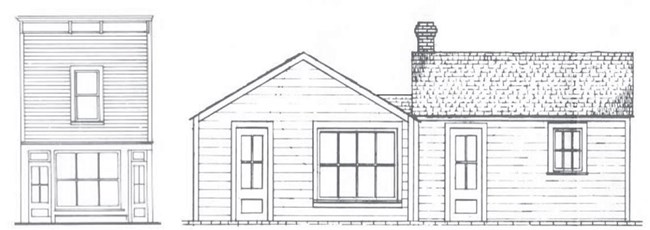
NPS photos 
NPS image Of Cigars and Men
Part of the boom-town atmosphere in Skagway during the early months of the Klondike gold rush was prostitution. A reporter in Skagway at the time wrote that "When a steamer whistled in the bay it was not unusual to see two men carefully inspecting each other's coat sleeves and collars in search of lingering hairs, for there was considerable wind in Skagway that summer, and hairs - red, blonde, and brunette - were wafted thither and thence by it and were likely to cling to any coat that happened by, and a great deal of trouble was saved by these pre-steamer inspections." Prostitutes often worked out of one-story shacks, known as "cribs."
One area that housed prostitutes (off Broadway between 4th and 5th Avenues) was known as French Alley, and it was here that Frederick Verbauwhede capitalized on the male clientele by opening a cigar store in February, 1898. To expand his business, Verbauwhede bought a small lot on Broadway near the new railroad depot in September, 1899 and built a new two story store, selling tobacco products and confections such as candy, nuts, and fruits. In 1902, he moved his cribs from French Alley to behind the store; the crib closest to the store served as a residence for Frederick and his family, while the other crib (and the second story of the store) was rented out to lodgers.
Jewelry, Guns, and Taxis
As business began to decline in Skagway, the Verbauwhedes sold their business to a local barber and left town. But the buildings' proximity to the wharves and the railroad depot would guarantee that they had a steady flow of traffic, and subsequent businesses would capitalize on this. In 1911, Emil Richter opened a jewelry and curio shop in the building; within two years he had moved his business to a larger building to the south, and this business is still operating today. In 1916, stampeder and gunsmith James Green purchased the buildings and advertised himself as an outfitter, guide, handyman, and dealer in secondhand goods, in addition to the gunsmith business. Longtime Skagway resident Frank Suffecool purchased the building in 1925 after Green passed away. For the next twenty years he operated the Alaska Transfer Company, an express business, out of this building. He also operated a taxi service for tourists.
Gasoline, Liquor, and Travel
From the end of World War II to 1977, there were eight different owners of the building and various businesses operated out of it. A gasoline pump was installed in the 1940s and the various owners emphasized gas sales. In 1965, bar owner Malcolm Moe purchased the building and added liquor sales until he purchased another building for this purpose. Atlas Travel Services operated a travel agency in the building until 1977, when the building was purchased by the National Park Service. Restoration and the Historic Leasing Program
The National Park Service purchased these buildings because of their historical significance to the Klondike Gold Rush. The many stories represented by these buildings reflect the changing character of Skagway's economy and history. Restoration to their gold rush-era appearance took place in 1985 and 1986, and the buildings were subsequently placed into the park's historic leasing program. Verbauwhede's Cigar Store, Confectionery, and Cribs are among a dozen historic buildings owned by Klondike Gold Rush National Historical Park. The cigar store building is leased to a private business under the provisions of the National Historic Preservation Act. Today the crib buildings are used by the law enforcement part of the park. Annual lease payments help offset the costs of maintaining these and other historic buildings in the park. The compatible commercial use of Verbauwhede's structure continues Skagway's long tradition as a bustling center of business activity. For more information about Klondike Gold Rush National Historical Park, please visit the Visitor Center at 2nd and Broadway. For more information on Skagway's historic district, ask for the "Skagway Walking Tour" and the "Gold Rush Buildings in Skagway Restored By the National Park Service" brochures.
Learn More!
|
Last updated: December 9, 2019
